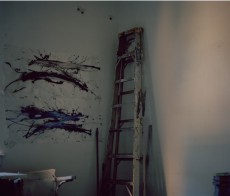NY Issue : Interview with Meguru Yamaguchi
NeoL / 2017年11月30日 1時45分
NY在住の日本人アーティストの中は数多くいるが、いま一際注目を集めているのが山口歴である。東洋と西洋双方の文化から影響を受け、グラフィティやカフィオグラフィを昇華させた独自の筆致をアクリル、樹脂、スプレーなどを用いて表現。ストリートとファインアートをも自在に行き来しているかのように見える山口に、過去、現在、未来を聞いた。
――まず画家を志した動機とNYに移るまでの過程を教えてください。なんでも鳥山明先生がお好きだったそうですが。
山口「そうなんです。鳥山明先生は未だに大好きなんですが、一生敵わないじゃないですか。だから漫画家はやめようと。親父がファッションデザイナーだったんですけどその生活を見ていても大変そうだし、ファッションも違うな。だったら絵しかない。これだったら自分の良さも出しつつ、やりたいこともできながら楽しくおもしろいことをできるかなと思って画家を目指しました。絵は小さい頃から好きだったけど、色々遊んでいた時期もあったので、本気で始めたのは高校卒業してからです。美大受験のためにデッサンも油絵もめちゃくちゃ頑張って基礎固めしたんですが、受験に失敗してしまって。でも、そこで客観的に考えることができないんですよ。日本でアーティストになるというとまず美大芸大に行かなくてはいけないというマインドセットがある。でも実際苦労して入って卒業してもアーティストになっている人は稀有で、よほど有名な奈良美智さんクラスの人しかいない。そういう現実を見て、既存のルートに乗らずとも画家として生きていける方法がないかと。そんな時にMATZU(松山智一/画家)さんとたまたま会う機会があり、東京での展示のアシスタントをすることになって。いろいろ話を聞いてみるとNYは日本と違って自由らしいと。それで23歳くらいのときに勢いで来てしまいました。逆に23歳くらいだったから来れたのかな」
――NYと日本で一番大きく違うと感じた点は? 先ほどおっしゃっていた芸大を出ていなくても、というところでしょうか。
山口「それが知れば知るほど、意外と学歴が重視される社会で(笑)。NYのダイチプロジェクトでの展示で見て衝撃を受けたクリスティン・ベイカーもイェール大学を出ていたり、感覚的な印象を受ける人たちのほうが一流大学出ていて。だからこそ自由にできている気もしますし、逆にNYのほうが学歴社会なんだなというのは来てから感じました。ただここ5~6年でソーシャルメディアによって一変しましたよね。自分で発信できてしまうので、国境や学歴が関係なくなってきている。どこをベースにしているかという意味での場所は重要だとは思いますが、どの国にいようと優れたアーティストはSNSですぐにピックアップされるし、死んでから評価されるというパターンは現代ではあまりない。NYのアートシーンもここ数年で中堅ギャラリーが軒並みクローズしていますし、大手ギャラリーとの格差が顕著になってきていると思います。ミレニアル世代のアーティストはSNSで発信できてそこで売買して完結してしまったり、ブルックリンにも若いアーティストが自分たちで経営するギャラリーも増えました。以前名和晃平さんにお会いしたときに『これからは個人がメディアになる時代だからね』とおっしゃっていて、どういう意味なのかなとずっと考えていたんですが、こういうことだったのかなと。しかしながら大部分のアーティストの目標は未だにDavid ZwinerやMary booneのような大手ギャラリーで展示することだと思うんですよ。スタートアップのギャラリーが増え、中堅ギャラリーがクローズして、大手だけが残って行くなかで、架け橋の無くなった若手がどうやってそのシーンに切り込んで行くかが課題だと思っています」
――一方でベースとなる場所が大切という意味もわかります。日本では海外にいるアーティストへのリスペクトが高い気がします。逆輸入で名前が売れるアーティストが多かったり。
山口「僕もNYにいるからこうして活動できているという面は否定できないです(笑)。僕を含めて日本人はNYに対する憧れが大きいので、ブルックリン発というと聞こえが良かったり。聞こえがいいというレベルの情報で、条件が変わるんですよね」
――いま、歴さんはファインアートとして見られていますよね。
山口「どういうふうに見られているのかはわからないのですが、僕は中間を行ってるつもりではあるんです。例えば、最近KAWSが日本の美術業界では持ち上げられていますけど、僕が20歳くらいのときはストリートのアーティストだったんです。格好いい作品を生み出していたし、NIKEともコラボしていたりして、それがファインアートしてアメリカで一番押し出されていてーーそういうのがいいなと。日本ではそういうことはまだなかなかない気がします」
――確かに日本では両者の区分がはっきりして交わらないかもしれませんね。失礼な話かもしれませんが、「Meguru Yamaguchi」で検索するとまず「価格」と出てくる。それはなかなかファインな感じがして(笑)。
山口「ありがたいですよね(笑)。所属はしていないんですが取り扱いギャラリーはいくつかあって、最初は値段が出ていたんですが今は伏せているんです。だからみんな調べるんですかね。それもオンラインでの見られ方や立ち振る舞いのひとつというか」
――なるほど。歴さんの作品はヴィジュアルとして強いというのも魅力になっていると思います。
山口「それは真剣に考えて取り組んでいるところです。最近壁画を始めたのですが、その理由もインスタなどを意識した仕掛けのつもりです。人の目に留まるものは、やはりデカいもの。僕自身タイムラインで見ていて目が留まるものはビルや空、大きいアートピースなどで、瞬間的にいいねを押してしまうんです。あとはコントラストが強い作品。今更壁画というのも30歳からいきなりラップを始めたみたいな感覚ですが、やってしまおうと」
――大きいものを目指すというのもNY的だなと。先ほどに続いてこれまた失礼ですが、大きさに比例して価格も上がる。
山口「家の大きさも違いますし、その壁に飾られるアートは必然的に大きくなりますよね。それが売れればアーティストはまた大きなスタジオを借りれるし。そういう意味では大きさが正義というのはありますね」
――壁画はいつから始められたんですか?
山口「CHARI&COというブランドで2013年に壁画をやらせてもらったんですが、ずっと試行錯誤していて。そのあとにrag&boneニューヨークでもやらせてもらったのですが、実際に見るととても良いものでもオンラインで見るとインパクトが弱いと感じたんです。4年くらいその理由を考えて、僕は壁に描くことをキャンバスのように四角の中で小さく考えていたなと。街の一部としての捉えなくては駄目だと気づいて。そのスケール感で描いてみようとスタジオの壁に描いたら、話が来るようになったので正解だったんだと思います」
――作品を見て、Futuraもお好きなんじゃないかなと思ったのですが。
山口「大好きですね、やはりストリートアートには大変影響を受けています。でもFuturaが日本で美大受験したら絶対に受からないじゃないですか。何が違うのかと考えたら、カルチャーに行き着くんですよね。Futuraのスタイルはもちろん格好いいんですが、それ以外のところにも価値があると思うんです。絵だけの価値だけではなく、音楽やファッションとも結びついていて、リアルだった。NYではヒップホップも日常なんですよ。他国の人達が表層的な部分だけ捉えてやるのとこっちのリアルでは全く違う。逆説的に言えば、だからこそ東京で生まれたストリートカルチャーはおもしろいんですよね。江戸時代に鎖国して浮世絵がオリジナルになっていったように、閉じられている良さや、コピーが独自に発達していく良さもあると思います。だからどっちが良い悪いとは言えないですけど、ソーシャルメディアの発達でそれもまた崩れつつある」
――音楽で言うと洋楽に近いものは海外での評価が厳しく、ヴィジュアル系のように独自の変化を遂げたもののほうが受け入れられたりとオリジナリティが求められると思うんですが、歴さんの作品は日本独自でもなければ海外の影響だけでもない、どちらでもないもののような気がしていて。
山口「全部ミックスしていますね。もともと書道をやっていたんですが、ヨーロピアン・ペインティングも基礎からやっていましたし、自分の全部の経験が出ているのかな。ミックスCDのようなレイヤーというか」
――さらにプロデューサー的な考え方もできる。
山口「そうかもしれない。何が廃れないのかなとか考えた時に筆跡に行き着いたので。ゴッホの絵もストロークが残っていて、どの時代でも国でも筆跡はあるし、残っている。これを極めたらただのファッションでは終わらないのかなと。そう思って10年毎日描いたんですよ」
――23歳からの10年?
山口「そうです。そこだけは負けないように1日1筆は必ず描いて、僕にしか出来ない自分のストロークでというのをずっと練習していました。楽しいからやっていただけだったんですが、振り返ってみて、廃れないオリジナリティを求めていたんだと気づきました」
―――その筆致を際立たせるために樹脂であったりアクリルであったりというマテリアルが適切だったんですか?
山口「はい。早く乾かないから油絵が苦手だったんですけど、アクリルはすぐに乾くので」
――立体でビジュアル的にとても映えますね。スプレーも使われていらっしゃいますが。
山口「スプレーもレイヤーなんです。少しだけ使っているんですけど、マテリアルでスプレーを入れるとストリートの良さも入るので。オイル・ペインティングだったらスプレーは使わないんですけど、自分だったらストリートに影響を受けたから取り入れる。それもブランディングなんです。僕が言うブランディングというのは、有名になるためというより、自分が格好いいと思うのはなんだろうと突き詰めて、掘り下げて、固めていくことです。ある時自分が心から納得いったら作品が売れる、ということ事に気付きました。自信過剰ということではなく、逆に売れることを意識して作ったものは売れず、純粋に格好いいと思うものが売れていったという実体験が根拠になっていて。だから、良い作品を作るということにしかフォーカスは置いてないです」
――しかし歴さんのミックスが何故受け入れられたのかというのは、やはりすごく興味深いです。日本画や浮世絵が受け入れられるのはわかりやすいですけど、西洋の要素が入っていると厳しい目で見られるはずなので。
山口「それはたぶん日本人だからだと思いますね。ミックスの文化が備わっていますし。食事にしても、日本人って他国のものを取り入れてその国より美味しいものを作ってしまったりする。そういうサンプリングやミックスが特性だから、多分僕だけじゃないと思うんですけどね。僕が特別上手いとは思っていないですけど、センサーやアンテナは常に張っていますし、子供の頃から今日まで、日本でもアメリカでもギャラリーや美術館で世界中の色んな作家の作品を見たり、インスタグラムでも毎日コンテンポラリーアートのチェックをしていて。インプットは随分したから、これを出せば格好いいものが生まれるという事は大体わかっている気がします。大量に良質の音楽を聴いていたらミックスCDも格好いいのを作れるじゃないですか。そういう感じですかね」
――センスに加え、やはり筆致を10年極め続けたことも重要だと思います。
山口「SNSなどで注目を集めることはできても、耐性や強さがないと残らないので1つの事を追求する職人的な要素も必要になっていきますよね。基礎の勉強もしっかりしていたことも幅になっていると思いますし。ソーシャルメディアに甘やかされて、基礎も礼儀も知らないままに有名になる子もいるので、そういう子が増えたらどうなんだろうと思うこともあります。昔よりも更に人間関係が重要になってるとも思います。SNSで手軽に有名人とつながれる時代だからこそ、誠実なアーティストが周りに残ってる気がします。アートシーンに関して自分も含めてなんですが、オンラインやタイムライン上で美術館やギャラリーの展示をチェックして“行ったつもり”になってしまうというのが怖いことだと思います。また逆説になってしまうんですが、インターネット全盛の時代ですが、オンラインやiPhoneの画面からでは絶対にわからないというのがアートの持つパワーだと信じています」
――時代の変遷期ですよね。
山口「ええ。3、4年前とはまた違う動き方しないといけないとは感じています。だから僕も壁画をやったり、常に新しいことを仕掛けていて。ここ2年くらいで3D(立体)の筆跡のシリーズも始めました。それも元々はインスタグラムからインスピレーションを受けたんですが、iPhoneで見た情報をインプットして、どうアウトプットし、それがまた他のiPhoneでどう映るのかということを考えていくのもおもしろいですよね。みんなが有名になれる時代になったからこそ、実際に見た時もヤバいものを作りたいし、そのためには絶対的に努力が必要で。『ヤバい!』を持続させるにはどうしたらいいかは僕も常に模索中ですけど、幅も持続力も持っていると思うので楽しんでいますし、まだまだ楽しめると思っています」
――強い、はやい、スマートで、さらに基礎と忍耐がある。最高ですね。最後に、何かアナウンスがあれば。
山口「来年また大きなプロジェクトが数個あります。今年はソロショーが4つあったので展示はちょっとお休みして、新しいことを実験する期間にしています。ブロンクスの歴史ある大通りでの壁画のプロジェクトも年始から始まるので。ありえないくらい規模で、でかい壁画を描いて常にワクワクしていたいです」
山口歴
http://www.meguruyamaguchi.com
photography Diego Garcia
text & edit Ryoko Kuwahara
---First of all, tell about your aspiration and motivation to become a painter and what the process was like until you moved to NY. Seems like you liked Akira Toriyama.
“That’s right. I still love Akira Toriyama but I will never be able to be as good as him. So I decided not to become a manga illustrator. I also knew fashion wasn’t my thing either because my father was a fashion designer and I saw that he was constantly busy. That’s why drawing is my only choice. I started working towards my goal of becoming a painter because I thought I would be able to show my goodness, while having fun and doing interesting things. I have loved art since I was little, but I had phases where I was just playing around so I didn’t become really serious until I graduated from high school. I worked really hard to concrete the basic in sketching and oil painting, but I failed the university entrance exams. But I could not think objectively at the point. There’s a mindset that you have to go to an art school in order to become an artist in Japan. In reality, there’s only a few that succeed after working really hard like the people who are in the famous Yoshitomo Nara’s class. Seeing those kind of realities, I started to wonder if I could become an artist without taking the the existing route. That’s when I coincidentally got the opportunity to meet MATZU, where I was an assistant at an exhibition in Tokyo. I asked him a lot of things, and learned that there is much more freedom in NY unlike Japan. That’s why I came to NY by impulse when I was 23. I actually think I was able to come because I was 23.”
---What were the major differences between NY and Japan that you felt? As you just mentioned, was is how you were able to succeed without having gone to university?
“Actually to my surprise, the more I expected I came to realize that academic backgrounds were put in consideration quite a lot. (laughs) Most of the people who gave me sensual impressions had graduated from the best known schools, like Christian Baker, who impacted me at the Daichi Project exhibition in New York, has graduated from Yale University. I think that that’s what allows them to have freedom, and I did not realize how much New York is a school-oriented society until I came here. But things have changed in the past 5 to 6 years due social media. National borders and academic backgrounds do not matter anymore because social media has enabled us to post things ourselves. Location is important in the sense of where an artist is based, but all talented artists receive attention on social media in no time regardless of which country they’re at. Nowadays, there are fewer cases in which an artist gets attention after their death. Rows of middle class galleries have been closing down the past few years, and I think the difference between them and the big corporations have become remarkable. Artists of the millennial generation post their works on SNS and just end it there, and more and more young artists have started to run their own galleries in Brooklyn. When I last met Kouhei Nawa he said ‘From now and on it’s going to be a generation where individuals are the media`, and I had been thinking what that actually means for a while, but I think this it was he was talking about. In spite of that, I think many artists still aim to exhibit their works at big museums like David Zwiner and Mary Boone did. With start-up galleries increasing, middle class galleries closing down, and major museums being the only ones remaining, I think the task for young artists, who have lost an intermediator, is to figure out how to get into the scene.“
--On the other hand, you mentioned that where they are based is important and I really understand. In Japan, I feel like there is a lot of respect for artists abroad. Like there are a lot of artists whose names sell due to reimport.
“I can’t deny the fact that I am able to take action like this because I am New York. (laughs) Japanese people have a lot of yearning towards NY, like being based in Brooklyn could sound attractive to them. I guess the condition can alter by the way how good something sounds.”
--Right now, I guess your works are seen as fine art?
“I am not sure how my works are being seen, but I intend to be in the middle. For example, KAWS is recently is being raised by the art industry in Japan, but he used to be a street art when I was 20 years old. He has created cool art, collaborated with Nike, and that was shown the most as fine art in America. I want to be like him. I feel like that’s not very common in Japan.
--That’s true how the division of both sides isn’t exchanged very cleary. This may come off rude, but ‘price’ comes up first when I search ‘Meguru Yamaguchi’. I thought it was pretty fine. (laughs)
“Yeah, it’s something to appreciate. I don’t belong to it, but there are a few galleries that handle my works and at first the price appeared but I am concealing it right now. So, I guess that’s why everyone searches it. That’s also one way of being seen as well as behave on social media.”
-- I see. Your works are very powerful in terms of visuals, and I think that makes it very captivating.
“That’s something I take into serious consideration. I started mural painting recently, but my reason for that was I intended it stand out on Instagram. Things that catch people’s attention are big objects. When I’m looking at my timeline I instantly like photos of buildings, the sky, and huge art. Works with a strong contrasts as well. Starting mural painting at 30 years old is crazy but I just went for it even though it might have been kind of late.”
--I thought it was very NY to make something big. This might come off rude once again, but the price gets higher as the bigger it is.
“Houses are bigger, so the size of art that they can put up naturally becomes bigger too. If that sells, artist can purchase bigger studios too. In those terms, is there is righteous to the size of art. “
--When did you begin mural painting?
“I got the opportunity to do a mural painting for CHARI & CO in 2013, but it was always just trial and error. After that, I got the opportunity to do one for Rag & Bone and it looked really nice in person, but there wasn’t enough impact when I saw it online. I thought about that for about 4 years, and I thought I want to stick to painting in a small square canvas. Then I noticed that I have to be a purpose of a part of the city. When I tried to paint in that scale and painted on the studio wall, I knew I was doing the right thing because I started to get offers.”
--Looking at your works, I thought that you must like Futura as well.
“I love it. After all, street art has impacted me greatly. But I am sure Futura would not have passed the entrance exam for Japanese art universities. At the end of the day, there’s difference in culture. Futura’s style is definitely cool, but there’s some other value to it too. It’s real because it connects to music and fashion, not just paintings. Hip Hop is an everyday affair in New York. It’s completely different when foreigners do it with just the understanding of the surface level, and the people here do the real thing. Paradoxically, that is why the street culture created in Japan is interesting. Just like ukiyoe became something original after the national isolation in the Edo period, there are good things about isolation, and sometimes copied things can develop into something original. So I can’t say where it’s good or bad, but the development of social media is kind of ruining that.”
--In terms of music, music similar to western music is evaluated very harshly, but genres that have developed a sense of originality like Visual-kei are accepted more easily so I think people want originality. I feel like your works are neither just Japanese nor foreign influenced.
“Yeah, it’s a mixture of everything. I did calligraphy initially, but I have learned european painting from the basics, so I guess all of my experiences is exposed in it. It kind of has a similar layering to a mixed CD.”
--Moreover, you can think like a producer.
“Maybe. When I thought about what won’t obsolete, I stumbled to stroke. Strokes remain in Gogh’s works, and all generations and countries have strokes. I thought if I master this, it would be more than just fashion. So, I did draw every day for ten years.”
--Ten years since you were 23 years old?
“Yes. I did it at least once a day and practiced all the time in order to master a stroke that only I can do. I was doing for fun, but look back at it I realized that I was doing it because I wanted originality that would not obsolete.”
--In order to accentuate the stroke of the brush, were materials such as acrylic and epoxy resin on wood suitable?
“Yes. I wasn’t good with oil paint because it doesn’t dry quickly, but acrylic dries really fastly.”
--It’s 3D so it looks very nice visually. Do you use spray paint as well?
“Spray paint is just a layer. I use a little bit of it to add the goodness of street. You don’t use spray paint in oil painting, but I was influenced by street art so I incorporated it into my works. That’s also a way of branding. For me, branding is searching for what I think is cool, delving into it, and solidifying it. It’s not to become famous. At one point, I realized that the works that sell are the ones that my heart is satisfied with. It’s not overconfidence, but in my experience the things that I thought about selling while making it don’t sell well and the things that I made because I genuinely thought looked cool actually did, so that became my basis. That’s why I only focus on making a good piece of art.”
--Yet I am still very interested in why the mixed works of yours were accepted. The acceptance of Ukioe is easy to understand, but it also has an essence of Western influence so I thought it would be be seen critically.
“That’s probably because I’m Japanese. We possess a mixed culture. Even when it comes to food, Japanese people take in a foreign culture and make it even better than the original. Things like sampling and mixes are really special. I don’t that I’m particularly talented, but I always keep aware, and I have visited galleries in Japan and in America to see works of artists from all around the world ever since I was a child up to this day. I also see contemporary art on Instagram every day. I have gotten so much input, so I have a feeling that I can make something really cool for sure if I made use of that. Just like you would be able to make good mix tape if you had listened to a lot of good quality music. It’s kind of like that.”
--Besides the good taste you obtain, I think it’s really important that you continued working on your stroke for over ten years.
“Being able to pursuit in one particular thing is vital in order to differentiate from others and attain attention on social media. Having studied the basics thoroughly has widen my opportunities. I wonder what will happen if the number of people who don’t know the basics nor the courtesy because they were spoiled by social media became really large. Human relations have even more important than before. I think faithful artists remain because this generation allows us to connect with famous people through social media. What I am worried about in the art scene is that it’s enables us to see what is being exhibited at galleries on our timelines and it makes us think that we went there, including myself. This is yet another paradox, but despite the fact that the internet is hitting its peak, the power of art that cannot be conveyed through the screen is something that I believe in.”--This generation is a big transition period, isn’t it?
“Yeah. I feel like i have to do something different from 3 or 4 years ago. That’s why I’m always trying out new things like moral paintings. In the past 2 years, I started a series of 3-D handwriting as well. That’s also something I absorbed from Instagram, but it’s interesting to think how I can make that my own, share it, and how other people will react to it when they see it on their iPhone screens. Especially since it has become a generation that anybody and everybody has the ability to become famous, it’s really important to put in a lot of effort to create something that will make people say “wow” when they see it. I am always thinking what will make others people say “way”, but I enjoy attaining a variety of skills as well as endurance. I think I can still enjoy doing for awhile."
--You’re strong, fast, smart, and even more you have the basics and the patience. Amazing. Lastly, is there anything I can annouce?
“I have a few big projects planned for next year. I had four solo projects this year, so I didn’t do any exhibitions, and instead I’m experimenting with some new things at the moment. I’m starting a huge mural painting on a historical main street in Bronx at the beginning of next year. I want to paint insanely enormous walls and feel excitement from that all the time.”
Meguru Yamaguchi
http://www.meguruyamaguchi.com
photography Diego Garcia
text & edit Ryoko Kuwahara
関連記事のまとめはこちら
http://www.neol.jp/art-2/
外部リンク
この記事に関連するニュース
-
「私たちを人間として扱ってほしい」やまぬ爆撃、家族との別れ…ガザ脱出の友人を探し記者がエジプトへ「戻りたいけど誰も戻れない」【脱出者が語る惨状】
北海道放送 / 2025年1月18日 9時45分
-
この英語ってどんな意味?「 plot twist 」
OTONA SALONE / 2025年1月11日 7時0分
-
この英語ってどんな意味?「Wake up and smell the coffee.」
OTONA SALONE / 2025年1月4日 7時0分
-
英語で「お餅つき」はなんて言う?
OTONA SALONE / 2025年1月3日 17時30分
-
この英語ってどんな意味?「That’s life.」
OTONA SALONE / 2024年12月27日 17時30分
ランキング
-
1片頭痛の前兆・予兆とは? つらい痛みを和らげる方法
マイナビニュース / 2025年1月21日 11時0分
-
2「メニューしょぼくなりすぎ」「粉チーズ有料とか…」サイゼリヤ“不満噴出でも最高益”の矛盾のワケ
女子SPA! / 2025年1月18日 8時47分
-
3太陽光パネルの買い換えは高額だと思うのですが、それに見合うメリットはあるのでしょうか? また、補助金などは出ないのでしょうか?
ファイナンシャルフィールド / 2025年1月18日 3時50分
-
4“あおり運転”してきた黒いハイエースの意外すぎる正体。運転手が青ざめた表情で平謝りするまで
日刊SPA! / 2025年1月21日 8時52分
-
5「フジテレビ問題」の根源は"経営不在"にある 2010年代から「一人負け」に陥ってしまった
東洋経済オンライン / 2025年1月21日 9時20分
記事ミッション中・・・
記事にリアクションする
![]()
記事ミッション中・・・
記事にリアクションする

エラーが発生しました
ページを再読み込みして
ください










